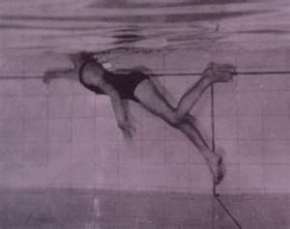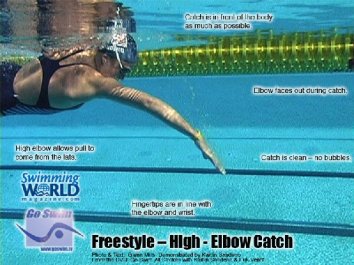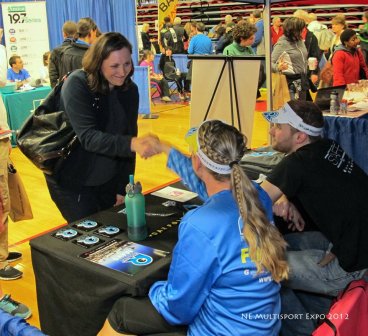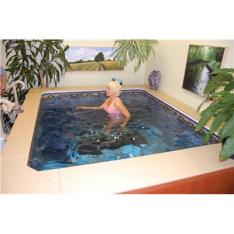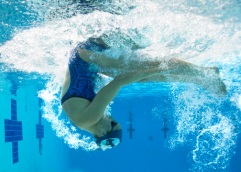(Classic “fitting” shot on my new-to-me Quintana Roo Seduza! Although the two main components (the bike and the jules) in this picture appear to be normal sized, it’s just an allusion; we’re just both mini. 🙂 More fun (funny?) pictures follow…)
As many cyclists and triathletes will admit, a professional bike fitting can ostensibly seem to be a big, unnecessary cost. We will also admit, that’s just not the case. Professional bike fitting is a bit of a nebulous term– the costs range dramatically between bike shops (and friends who know bikes “real well”) and the actual service itself ranges as well. There isn’t one, best way to ensure a great fit for a new or even old bike. That isn’t only because each person’s shape and flexibility is different but when you add the complex geometry of the bike, the differences between cyclists is exponential (or factorial, actually). I think women might best understand this by thinking about the ways that clothing fits… or doesn’t… even if technically a size 6 should just be a size 6, right? Yeah, I know, never that simple. Guys- your clothing is ridiculously simple so the analogy stops there.
Why get fit? A proper fit bike will make your time on the road and trail (or the race course) more enjoyable and maximize efficiency. Whether it’s a new or old bike, you could probably benefit from finding optimal riding position (even if it’s just YOU who’s changed and the equipment is the same). If that weren’t enough reason, a “fitting” is the type of initial cost that has a long term benefit in injury prevention– and let me tell ya– nothing is worse than being a sidelined athlete. Often things such as: saddle sores, sore knees, tweaked hips, lower back aches, shoulder strains and neck soreness are directly related to your bike fit. I don’t want to overpromise here (note: I’m not even a good cyclist let alone an actual bike fitter!), but I have also read and heard that a good, tight fit on the bike can lead to an overall increase in output by 10% (I presume this is talking about wattage). So, to recap you might consider a bike fitting if you’re a) new to the bike, b) dislike being injured, c) want to increase cycling efficiency or d) want to be faster. If you want none of these? well, you’re probably not reading this blog.
What is involved in a bike fitting? That depends.
1. The basic fitting: although it might vary a little from shop to shop, for the most part the basic fit will analyze the following:
- Pedal-shoe interface (yep, this is actually variable and can be optimized based on your quad/hamstring flexibility)
- Seat height (fore/aft)
- Cockpit sizing (handlebars, brakes, gear components)
- Bar/stem height, length, rotation
- Handlebar placement
- Aerodynamic position
- Proper Pedaling Mechanics–how to effectively pedal, so the power will be transferred to the pedals.
Cost? Usually around $80-100. OFTEN this will be included in a bike purchase! So make sure to ask. It might be discounted if you spend some money on gear and equipment too. I’d say this is basically mandatory for anyone getting a new bike, but possibly insufficient for a seasoned cyclist looking to ameliorate aches/pains or improve pedal-to-power stroke.
2. The mid-level Option: The mid-level bike fitting is also completed by professional bike fitter. This fitting not only measures everything from a basic fit, but in addition adds in aspects of motion, flexibility, and angular momentum. Specifically, a professional fitter will look at your overall movement on the bike to see where you might have muscle imbalances (or flexibility differences), mobility, stability and strength (specifically core!) that will contribute to a great fit versus just an “ok” fit. These fittings span the gamut for price- you want to make sure this is going to be at least an hour’s session and just ask the bike shop what the fitting includes to make sure it’s really getting into the nit and grit of your cycling. The average costs I’ve seen? $150-$300. Communicate what you need and what you’re looking for and you’ll find that either a higher cost is justified (is the fitter recording the stroke and analyzing dynamically? might be worth a little more because then YOU get to see what he/she does!) or it’s a lower cost with less frills (just some extra expertise and dynamic analysis). Either way, I’d actually say this is worth it if you’re going to be cycling more than once a week– no matter the distance. If you’re getting on your bike that consistently, a bad fit will be contributing to overall pain in other parts of your life. And why invite that? No need for discomfort (well, no more than what happens in daily, grinding workout sessions of course).
3. The High-Tech Option: There are really high tech fittings; these include clipping into your bike in a way that not only measures your power around the pedal stroke (watching for inconsistencies, or where the “waste space” of your pedal stroke is) but in addition this allows a sophistacated software system to understand where your flexibility is insufficient and should be “supplemented” by your position. The software/hardware combination does this by measuring the weight the foot is carrying around the stroke. Then in addition, they include the bike mechanics measurements included in the basic and pro fittings as well. These are completed by a professional bike fitter (certification is pretty stringent) and can run over $300 per hour. Yep, I know… that’s kind of pricey. Honestly, this isn’t money I (personally!!) would spend. This is because I know I could get a great (albeit slightly less fancy) fit for less, but also because I’m not talented enough to benefit from the delta in price (meaning, I might as well use the extra $$ to race some TT events and improve my handling). If you are a good to great cyclist– this might be a fun opportunity to explore your inefficiencies and improve your cycling in a way you are less likely to by cycling through the same motions that you have for multiple seasons. Fewer places offer something like this though, so it’s usually worth a quick google search (Aw, I know, you just wanted an easy link right? try this: http://ww1.lmgtfy.com/).
I have been incredibly fortunate to be introduced to a fantastic cycling couple– Don and Elaine Vescio who run the triathlon center VMPS, which I’ve mentioned before. Don and Elaine led computraining sessions I took part in all winter; they analyzed my pedal stroke, they told me to stop pedaling a bike that was too big for me, they let me borrow a bike when mine was stolen!, and have been incredible mentors in all things triathlon. In addition, Don helped me not only pick the bike I so badly needed in order to train and compete (to replace my sad stolen TREK) AND helped fit me to the bike. In fact, we are still working on optimizing the fit and the components to suit my exact needs! It was a laborious effort on Don’s part– it’s definitely a pro-fitting (and beyond, really), which he offers anyone for a very very reasonable rate and the time and care and expertise that he has are worth much more. And because we were having fun– we took some pictures! Good fit, right?? Pretty aggressive and tight and I’m lucky to have the flexibility for it (or so we hope!). I’ve only clocked ~100 miles on her, but I’m happy so far!
Tell me– what’s your experience? Is the bike fitting worth it? Are there tell-tale signs of a successful fitting? Any requests you’d make specifically to improve a fit?

![DSCN0396[1]](https://juliauntapered.files.wordpress.com/2012/05/dscn03961.jpg?w=368&h=276)
![DSCN0394[1]](https://juliauntapered.files.wordpress.com/2012/05/dscn03941.jpg?w=430&h=322)
![DSCN0393[1]](https://juliauntapered.files.wordpress.com/2012/05/dscn03931-e1336053877257.jpg?w=258&h=429)

